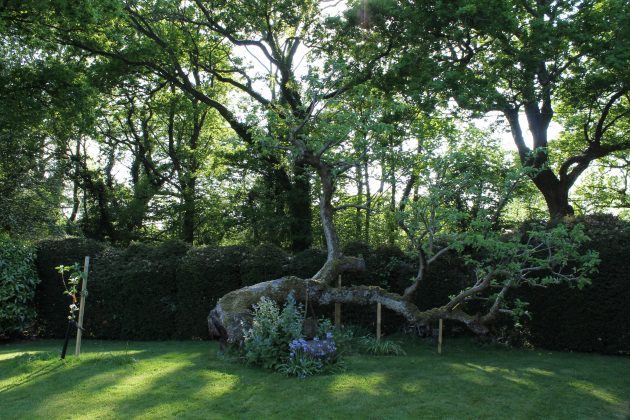
A fallen Sussex apple tree has led to an exciting discovery: the last remaining Bossom apple tree in Graffam has been found to be one of two.
Last year an old apple tree at the Blue Idol Quaker Meeting House at Coolham, near Billingshurst, fell without being uprooted. Although very old – quite possibly over 100 years old – the tree was propped up and managed to survive. The age and condition of the tree raised questions about what variety it might be, and if it was worth preserving by taking cuttings for grafting.
Roger Brown of the Steyning Community Orchard was the initial contact at the start of the investigation into the origins of the Blue Idol Bossom story. He organised the genetic testing of the variety to confirm its identity as well as arranging the propping up of the old tree and planting a future replacement nearby.
How to Identify Old Fruit Trees
Where there is no history, the identification of old trees can be difficult. If grown from a pip, it would be unique, though possibly very similar to one of its parent trees. Matching to a description in the National Apple Register is possible, but local conditions of soil and light might produce fruit at variance with the description. However, genetic testing allowed identification against the DNA database of the National Apple Collection. Leaves from the Blue Idol tree were sent to the East Malling Research Centre where a match was made identifying the tree as Bossom.
The Bossom Family
Up to that point it had been thought the last remaining Bossom in Sussex was growing in a garden in the village of Graffham. When it fell in the storm of 1986, the variety was rescued by taking graft material from the stricken tree. The Bossom trees in the National Fruit Collection at Brogdale and in the Stanmer Collection are descendants of the Graffham tree. A new Bossom, supplied from the Stanmer collection, has been planted next to the old tree at the Blue Idol. Grafts from the Blue Idol tree, although genetically identical, now provide a second line of descent. The Blue Idol meeting house has a long history going back to at least 1580 and is well-worth a visit (but please check the website for details). It would make a fine day out with a visit to the rewilding project at nearby Knepp Castle Estate (where you’ll also find our apple juice for sale).
Hope for Other Extinct Varieties
As one part of the history of Sussex apples is expanded, there are varieties that, as far as we know, no longer exist. An example is the Petworth Non Pareil. We have the description, a medium-sized, green with a thin brown russet, firm and crisp. History tells us it was probably bred by the third Lord Egremont and his head gardener Mr Slade at Petworth House early in the 19th century, together with Egremont Russet and Bossom. If a Petworth Non Pareil does still exist, it is most likely in an old garden like the Blue Idol. It would be unlikely to have survived in a commercial orchard once past its most productive years. Of course, there is no DNA for identification, and no picture, just the description in the National Apple Register. Still, the latest finding does give some hope. If you’ve got an unidentified apple in your garden, check it out to see if it matches the description of these Sussex varieties or consider getting it genetically tested to see if there’s a match.